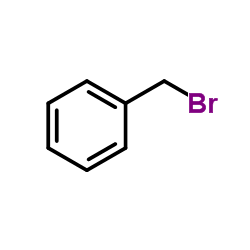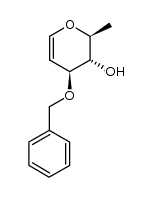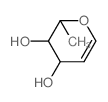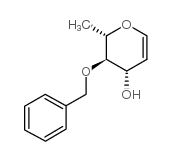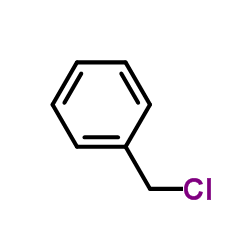117249-17-9
| Name | (2S,3S,4S)-2-methyl-3,4-bis(phenylmethoxy)-3,4-dihydro-2H-pyran |
|---|---|
| Synonyms |
3,4-di-O-benzyl-L-rhamnal
perbenzylated L-rhamnal 3,4,6-tribenzyl-L-rhamnal 3,4-di-O-benzyl-6-deoxy-L-glucal |
| Density | 1.12g/cm3 |
|---|---|
| Boiling Point | 434.2ºC at 760 mmHg |
| Melting Point | 111ºC |
| Molecular Formula | C20H22O3 |
| Molecular Weight | 310.38700 |
| Flash Point | 148.1ºC |
| Exact Mass | 310.15700 |
| PSA | 27.69000 |
| LogP | 4.08960 |
| Vapour Pressure | 2.45E-07mmHg at 25°C |
| Index of Refraction | 1.577 |
Synonym: Section 2 - COMPOSITION, INFORMATION ON INGREDIENTS
Risk Phrases: None Listed. Section 3 - HAZARDS IDENTIFICATION EMERGENCY OVERVIEW
Not available. Potential Health Effects Eye: May cause eye irritation. Skin: May cause skin irritation. May be harmful if absorbed through the skin. Ingestion: May cause irritation of the digestive tract. May be harmful if swallowed. Inhalation: May cause respiratory tract irritation. May be harmful if inhaled. Chronic: Not available. Section 4 - FIRST AID MEASURES Eyes: Flush eyes with plenty of water for at least 15 minutes, occasionally lifting the upper and lower eyelids. Get medical aid. Skin: Get medical aid. Flush skin with plenty of water for at least 15 minutes while removing contaminated clothing and shoes. Ingestion: Get medical aid. Wash mouth out with water. Inhalation: Remove from exposure and move to fresh air immediately. Notes to Physician: Treat symptomatically and supportively. Section 5 - FIRE FIGHTING MEASURES General Information: As in any fire, wear a self-contained breathing apparatus in pressure-demand, MSHA/NIOSH (approved or equivalent), and full protective gear. Extinguishing Media: Use water spray, dry chemical, carbon dioxide, or chemical foam. Section 6 - ACCIDENTAL RELEASE MEASURES General Information: Use proper personal protective equipment as indicated in Section 8. Spills/Leaks: Vacuum or sweep up material and place into a suitable disposal container. Section 7 - HANDLING and STORAGE Handling: Avoid breathing dust, vapor, mist, or gas. Avoid contact with skin and eyes. Storage: Store in a cool, dry place. Store in a tightly closed container. Section 8 - EXPOSURE CONTROLS, PERSONAL PROTECTION Engineering Controls: Use adequate ventilation to keep airborne concentrations low. Exposure Limits CAS# 117249-17-9: Personal Protective Equipment Eyes: Not available. Skin: Wear appropriate protective gloves to prevent skin exposure. Clothing: Wear appropriate protective clothing to prevent skin exposure. Respirators: Follow the OSHA respirator regulations found in 29 CFR 1910.134 or European Standard EN 149. Use a NIOSH/MSHA or European Standard EN 149 approved respirator if exposure limits are exceeded or if irritation or other symptoms are experienced. Section 9 - PHYSICAL AND CHEMICAL PROPERTIES Physical State: Solid Color: Not available. Odor: Not available. pH: Not available. Vapor Pressure: Not available. Viscosity: Not available. Boiling Point: Not available. Freezing/Melting Point: 111 - 113 deg C Autoignition Temperature: Not available. Flash Point: Not available. Explosion Limits, lower: Not available. Explosion Limits, upper: Not available. Decomposition Temperature: Solubility in water: Specific Gravity/Density: Molecular Formula: C20H22O3 Molecular Weight: 310.39 Section 10 - STABILITY AND REACTIVITY Chemical Stability: Stable. Conditions to Avoid: Incompatible materials. Incompatibilities with Other Materials: Strong oxidizing agents. Hazardous Decomposition Products: Carbon monoxide, carbon dioxide. Hazardous Polymerization: Will not occur. Section 11 - TOXICOLOGICAL INFORMATION RTECS#: CAS# 117249-17-9 unlisted. LD50/LC50: Not available. Carcinogenicity: 3,4-Di-O-benzyl-L-rhamnal - Not listed by ACGIH, IARC, or NTP. Section 12 - ECOLOGICAL INFORMATION Section 13 - DISPOSAL CONSIDERATIONS Dispose of in a manner consistent with federal, state, and local regulations. Section 14 - TRANSPORT INFORMATION IATA Not regulated as a hazardous material. IMO Not regulated as a hazardous material. RID/ADR Not regulated as a hazardous material. Section 15 - REGULATORY INFORMATION European/International Regulations European Labeling in Accordance with EC Directives Hazard Symbols: Not available. Risk Phrases: Safety Phrases: S 24/25 Avoid contact with skin and eyes. WGK (Water Danger/Protection) CAS# 117249-17-9: No information available. Canada None of the chemicals in this product are listed on the DSL/NDSL list. CAS# 117249-17-9 is not listed on Canada's Ingredient Disclosure List. US FEDERAL TSCA CAS# 117249-17-9 is not listed on the TSCA inventory. It is for research and development use only. SECTION 16 - ADDITIONAL INFORMATION N/A |
| Safety Phrases | S24/25 |
|---|
|
~91% 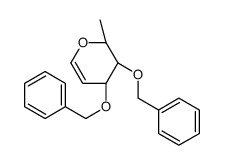
117249-17-9 |
| Literature: Nicolaou; Snyder, Scott A.; Nalbandian, Annie Z.; Longbottom, Deborah A. Journal of the American Chemical Society, 2004 , vol. 126, # 20 p. 6234 - 6235 |
|
~80% 
117249-17-9 |
| Literature: Madhusudan, Soni Kamlesh; Agnihotri, Geetanjali; Negi, Devendra S.; Misra, Anup Kumar Carbohydrate Research, 2005 , vol. 340, # 7 p. 1373 - 1377 |
|
~75% 
117249-17-9 |
| Literature: Vedachalam, Seenuvasan; Tan, Shi Min; Teo, Hui Ping; Cai, Shuting; Liu, Xue-Wei Organic Letters, 2012 , vol. 14, # 1 p. 174 - 177 |
|
~88% 
117249-17-9 |
| Literature: Zhao, Jinzhong; Shao, Huawu; Wu, Xin; Shi, Shaojing Chinese Journal of Chemistry, 2011 , vol. 29, # 7 p. 1434 - 1440 |
|
~18%
Detail
|
| Literature: Thiem, Joachim; Klaffke, Werner; Springer, Dirk Carbohydrate Research, 1988 , vol. 174, p. 201 - 210 |
|
~% 
117249-17-9 |
| Literature: Vedachalam, Seenuvasan; Tan, Shi Min; Teo, Hui Ping; Cai, Shuting; Liu, Xue-Wei Organic Letters, 2012 , vol. 14, # 1 p. 174 - 177 |
|
~% 
117249-17-9 |
| Literature: Zagar, Cyrill; Scharf, Hans-Dieter Liebigs Annalen der Chemie, 1993 , # 4 p. 447 - 450 |
| Precursor 5 | |
|---|---|
| DownStream 1 | |
